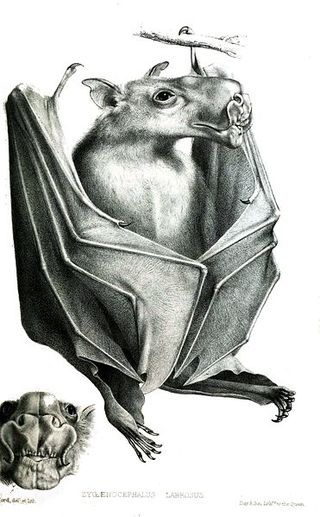
Hammer-headed fruit bat
Order : Chiroptera
Family : Pteropodidae
Subfamily : Pteropodinae
Species : Hypsignathus monstrosus
The Hammer-headed fruit bat is listed as Least Concern. Does not qualify for a more at risk category. Widespread and abundant taxa are included in this category, on the IUCN Red List of Threatened Species
Namings for the hammerheaded fruit bat
A young / baby of a hammerheaded fruit bat is called a 'pup'. A hammerheaded fruit bat group is called a 'colony or cloud'.Countries
Angola, Benin, Burkina Faso, Cameroon, Central African Republic, Congo, Democratic Republic of the, Congo, Republic of the, Cote d'Ivoire, Equatorial Guinea, Ethiopia, Gabon, Ghana, Guinea, GuineaBissau, Kenya, Liberia, Nigeria, Sierra Leone, Sudan, Togo and UgandaHammer-headed fruit bat habitats
Forest, Moist savanna, Savanna, Subtropical / Tropical Mangrove Vegetation Above High Tide Level and Subtropical / Tropical Moist LowlandSome facts about the
Hammer-headed fruit bat
Adult weight : 0.33 kg (0.726 lbs)
Female maturity :180 days
Male maturity : 420 days
Litter size : 1
Weight at birth : 0.04 kg (0.088 lbs)
Facts about the hammer-headed fruit bat
In Kenya, the Hammer-headed Fruit Bat is endemic to Kakamega Forest.
Hypsignathus monstrosus This single species, otherwise called the hammer-headed fruit bat, is known for its large sexual dimorphism characterised by the large size differences, hammer shaped head, large convoluted lips and the well-developed voice organs
The Hammer-headed Fruit Bat is endemic to Kakamega Forest, and is the largest bat on the African continent with a wing span of almost one meter and a huge head.
The Hammer-Headed Fruit Bat is one of Africa's largest bats with a wingspan of up to one metre. (Full text)
This fruit bat Hypsignathus monstrosus is not any danger to people. (Full text)
More animals beginning with H
